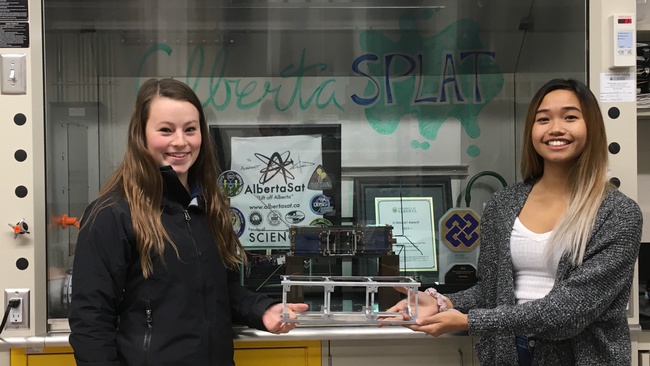The Icarus cubesat structure is AlbertaSat’s in-house design, and it is in development for the Ex-Alta 2 mission (a 3U cubesat). The inspiration for this design is twofold. Firstly, in order to reduce the cost of hardware, many of the components of Ex-Alta 2 are AlbertaSat designs and not COTS parts. This prompted a mechanical engineering capstone team to start the Icarus design on behalf of AlbertaSat. The team has continued with its development, including having produced an initial prototype.
The second inspiration focuses in its function: a stack-through design. Commercial cubesat structure options divide the internal volume into the traditional cubesat units. This provides interstage areas, but communication across these areas can be difficult to work with. A stack-through design maximizes the use of the internal volume, and interstage areas (for components like cameras) can be made artificially. Icarus has over 300 mm of internal space available versus the 225 mm of many commercial options.
The current iteration of the design is made mostly of hard anodized Al5052-H32, and stainless steel fasteners were selected. Vibration mode analysis of the CAD model shows that it exceeds launch requirements. Further iterations of Icarus will incorporate lessons learned from simulations, prototyping, testing, and assembly.
Mass: 317 g (without fasteners, mostly hard anodized Al5052-H32)
Material volume: approximately 101 cubic cm (again, without fasteners)
Outside dimensions: 340.5 x 100.0 x 100.0 mm (complies with cubesat standard)
Usable internal space: 314.8 mm (along z-axis, stack-through)
Unit cost: variable (AlbertaSat members volunteered their time to manufacture a prototype, the cost of materials was about $60)
Yes, compared to using a commercial cubesat structure, Icarus can reduce hardware costs while offering two advantages. First, the inspiration for its form is a stack-through design, which maximizes the amount of internal volume used by the various systems. Secondly, because it is open source technology, it can be adapted to best serve the purposes of the mission.
The Icarus cubesat structure is a structural component of the satellite; it does not require any power. Kill switches are integrated with the design so that the cubesat power system is disabled when it is placed inside the deployment pod.
The Icarus cubesat structure is a structural component of the satellite; it does not generate any heat. Its current design is made almost entirely of Aluminum 5052-H32, and as such its survivable range of temperatures are not a limiting factor on any conceivable cubesat mission. Unless special circumstances exist, the Icarus cubesat structure will accept excess heat from batteries and other heat-producing components. It dissipates this heat passively, emitting radiation to the cosmic background.
The Icarus cubesat structure is a structural component of the satellite; it does not generate any data.
The Icarus cubesat structure is a structural component of the satellite; it does not generate any data.
The Icarus cubesat structure is a structural component of the satellite; it does not have any bus stability or attitude control requirements. Its own centre of gravity adheres to the Cal Poly CubeSat Design Standard (Revision 13).
There are no other additional platform accommodation requirements for the Icarus cubesat structure.
The Icarus cubesat structure is in development for a current AlbertaSat mission, Ex-Alta 2. It conforms to the PC-104 form factor for PCBs and to the form factor of most solar cells. Because it is open source, its design can be modified to achieve integration with mission-specific hardware.
As more prototypes are developed by AlbertaSat and capstone teams, and as those prototypes undergo mechanical testing, improvements will be made to the existing design.
